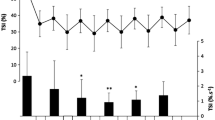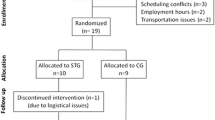Abstract
This study aimed to reveal the neural and muscular adjustments following a repeated-sprint (RS) running exercise. Sixteen subjects performed a series of neuromuscular tests before, immediately after and 30 min (passive recovery) post-RS exercise (12 × 40 m sprints interspaced by 30 s of passive recovery). Sprint times significantly lengthened over repetitions (+17% from the first to the last sprint; P < 0.05). After RS running exercise, maximal voluntary contraction torque of the plantar flexors (−11 ± 7.3%), muscle activation (twitch interpolation) (−2.7 ± 3.4%) and soleus maximal M-wave amplitude (−20 ± 17%) were significantly (P < 0.05) reduced but returned close to baseline after 30 min. Both soleus EMG activity and maximal Hoffmann reflex normalized with respect to M-wave amplitude did not change during the whole experiment. From pre- to post-RS exercise, evoked twitch response was characterized by lower peak torque and maximal rate of torque development (−13 and −11%, respectively, P < 0.05), but was not different from baseline after recovery. Peak tetanus at 20 and 80 Hz were 17 and 8% lower (P < 0.05) in the fatigued state, respectively. Acute muscle fatigue induced by RS running exercise is mainly peripheral as the short-term (30 min) recovery pattern of plantar flexors contractile properties follows that of the voluntary force-generating capacity.




Similar content being viewed by others
References
Andersen B, Westlund B, Krarup C (2003) Failure of activation of spinal motoneurones after muscle fatigue in healthy subjects studied by transcranial magnetic stimulation. J Physiol 551(Pt1):345–356
Avela J, Finni J, Komi PV (2006) Excitability of the soleus reflex arc during intensive stretch-shortening cycle exercise in two power-trained athlete groups. Eur J Appl Physiol 97:449–486
Balsom PD, Seger JY, Sjödin B, Ekblom B (1992) Maximal-intensity intermittent exercise: effect of recovery duration. Int J Sports Med 13(7):528–533
Billaut F, Basset FA (2007) Effect of different recovery patterns on repeated-sprint ability and neuromuscular responses. J Sports Sci 28(8):905–913
Billaut F, Basset FA, Falgairette G (2005) Muscle coordination changes during intermittent cycling sprints. Neurosci Lett 380(3):265–269
Bishop D, Edge J, Goodman C (2004) Muscle buffer capacity and anaerobic fitness are associated with repeated-sprint ability in women. Eur J Appl Physiol 92:540–547
Bringard A, Denis R, Belluye N, Perrey S (2007) External elastic compression and muscle function in humans. Sci Sports 22:3–13
Clausen T, Nielsen OB, Harrison AP, Flatman JA, Overgaard K (1998) The Na+, K+ pump and muscle excitability. Acta Physiol Scand 162:183–190
Davies CT, Young K (1983) Effect of temperature on the contractile properties and muscle power of triceps surae in humans. J Appl Physiol 55(1):191–195
Drust B, Rasmussen P, Mohr M, Nielsen B, Nybo L (2005) Elevations in core and muscle temperature impairs repeated sprint performance. Acta Physiol Scand 183(2):181–190
Dupont G, Millet GP, Guinhouya C (2005) Berthoin relationship between oxygen uptake kinetics and performance in repeated running sprints. Eur J Appl Physiol 95(1):27–34
Enoka RM, Stuart DG (1992) Neurobiology of muscle fatigue. J Appl Physiol 72:1631–1648
Farina D, Merletti R, Enoka RM (2004) The extraction of neural strategies from the surface EMG. J Appl Physiol 96:1486–1495
Fitts RH, Metzger JM (1991) Mechanisms of muscular fatigue. In: Poortmans JR (ed) Principles of exercise biochemistry. Karger, Basel, pp 212–229
Gibson H, Edwards RH (1985) Muscular exercise and fatigue. Sports Med 2(2):120–132
Gill ND, Beaven CM, Cook C (2006) Effectiveness of post-match recovery strategies in rugby players. Br J Sports Med 40:260–263
Girard O, Lattier G, Maffiuletti NA, Micallef JP, Millet GP (2008) Neuromuscular fatigue during a prolonged intermittent exercise: application to tennis. J Electromyogr Kinesiol 18(6):1038–1046
Girard O, Racinais S, Micallef J-P, Millet GP (2009) Spinal modulations accompany peripheral fatigue during prolonged tennis playing. Scand J Med Sci Sport (in press)
Godt RE, Nosek TM (1989) Changes of intracellular milieu with fatigue or hypoxia depress contraction of skinned rabbit skeletal and cardiac muscle. J Physiol 412:155–180
Hautier CA, Arsac LM, Deghdegh K, Souquet J, Belli A, Lacour JR (2000) Influence of fatigue on EMG/force ratio and cocontraction in cycling. Med Sci Sports Exerc 32(4):839–843
Jones DA (1996) High- and low-frequency fatigue revisited. Acta Physiol Scand 156:265–270
Kalmar JM, Cafarelli E (1999) Effects of caffeine on neuromuscular function. J Appl Physiol 87(2):801–808
Kinugasa R, Akima H, Ota A, Ohta A, Sugiura K, Kuno SY (2004) Short-term creatine supplementation does not improve muscle activation or sprint performance in humans. Eur J Appl Physiol 91(2–3):230–237
Lattier G, Millet GY, Martin A, Martin V (2004) Fatigue and recovery after high-intensity exercise Part II: recovery interventions. Int J Sports Med 25(7):509–515
Lavender G, Bird SR (1989) Effect of sodium bicarbonate ingestion upon repeated sprints. Br J Sports Med 23:41–45
Martin V, Millet GY, Lattier G, Perrod L (2005) Why does knee extensor muscles torque decrease after eccentric-type exercise? J Sports Med Phys Fitness 45(2):143–151
Mendez-Villanueva A, Hamer P, Bishop D (2007) Physical fitness and performance fatigue responses during repeated sprints matched for initial mechanical output. Med Sci Sports Exerc 39(12):2219–2225
Mendez-Villanueva A, Hamer P, Bishop D (2008) Fatigue in repeated-sprint exercise is related to muscle power factors and reduced neuromuscular activity. Eur J Appl Physiol 103(4):411–419
Millet GY, Lepers R (2004) Alterations of neuromuscular function after prolonged running, cycling and skiing exercises. Sports Med 34:105–116
Morana C, Perrey S (2009) Time course of postactivation potentiation during intermittent submaximal fatiguing contractions in endurance- and power-trained athletes. J Strength Cond Res 23(5):1456–1464
Racinais S, Girard O (2009) ITT: a tool to demonstrate muscle inactivation rather than to calculate a percentage of activation. In: Comments on point:counterpoint: the interpolated twitch does/does not provide a valid measure of the voluntary activation of muscle. J Appl Physiol 107:361
Racinais S, Bishop D, Denis R, Lattier G, Mendez-Villaneuva A, Perrey S (2007a) Muscle de-oxygenation and neural drive to the muscle during repeated sprint cycling. Med Sci Sports Exerc 39:268–274
Racinais S, Girard O, Micallef JP, Perrey S (2007b) Failed excitability of spinal motoneurons induced by prolonged running exercise. J Neurophysiol 97:596–603
Rupp T, Girard O, Perrey S (2009) Redetermination of the optimal intensity modifies resting H-reflex recovery after a sustained moderate-intensity muscle contraction. Muscle Nerve (in press)
Sale D, Quinlan J, Marsh E, McComas AJ, Belanger AY (1982) Influence of joint position on ankle plantar flexion in humans. J Appl Physiol 52:1636–1642
Schieppati M (1987) The Hoffman reflex: a means for assessing spinal reflex excitability and its descending control in man. Prog Neurobiol 28:345–376
Sinoway LI, Hill JM, Pickar JG, Kaufman MP (1993) Effects of contraction and lactic acid on the discharge of group III muscle afferents in cats. J Neurophysiol 69(4):1053–1059
Skof B, Strojnik V (2006) Neuro-muscular fatigue and recovery dynamics following anaerobic interval workload. Int J Sports Med 27(3):220–225
Strojnik V, Komi PV (1998) Neuromuscular fatigue after maximal stretch-shortening cycle exercise. J Appl Physiol 84(1):344–350
Taylor JL, Todd G, Gandevia SC (2006) Evidence for a supraspinal contribution to human muscle fatigue. Clin Exp Pharmacol Physiol 33:400–405
Author information
Authors and Affiliations
Corresponding author
Additional information
Communicated by Arnold de Haan.
Rights and permissions
About this article
Cite this article
Perrey, S., Racinais, S., Saimouaa, K. et al. Neural and muscular adjustments following repeated running sprints. Eur J Appl Physiol 109, 1027–1036 (2010). https://doi.org/10.1007/s00421-010-1445-3
Accepted:
Published:
Issue Date:
DOI: https://doi.org/10.1007/s00421-010-1445-3




